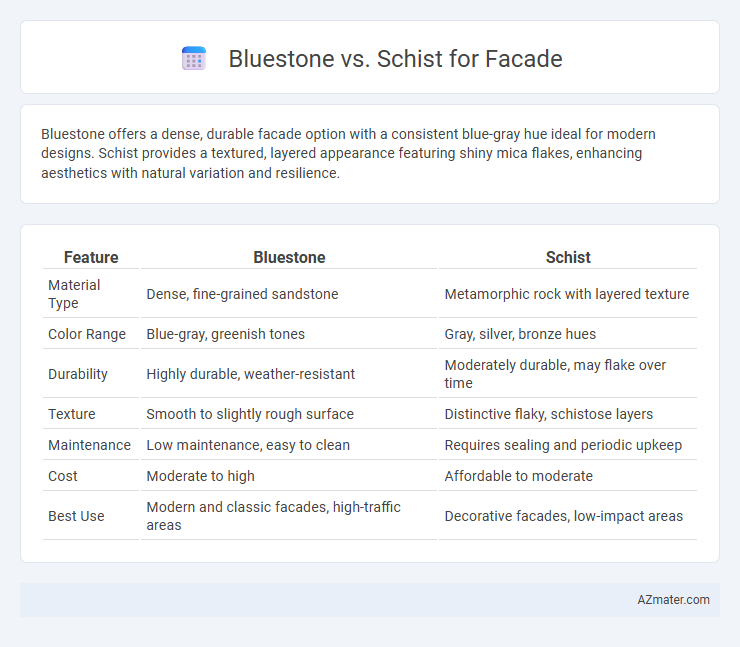Bluestone offers a dense, durable facade option with a consistent blue-gray hue ideal for modern designs. Schist provides a textured, layered appearance featuring shiny mica flakes, enhancing aesthetics with natural variation and resilience.
Table of Comparison
| Feature | Bluestone | Schist |
|---|---|---|
| Material Type | Dense, fine-grained sandstone | Metamorphic rock with layered texture |
| Color Range | Blue-gray, greenish tones | Gray, silver, bronze hues |
| Durability | Highly durable, weather-resistant | Moderately durable, may flake over time |
| Texture | Smooth to slightly rough surface | Distinctive flaky, schistose layers |
| Maintenance | Low maintenance, easy to clean | Requires sealing and periodic upkeep |
| Cost | Moderate to high | Affordable to moderate |
| Best Use | Modern and classic facades, high-traffic areas | Decorative facades, low-impact areas |
Introduction to Bluestone and Schist Facades
Bluestone and schist are popular natural stones used in facade construction due to their durability and aesthetic appeal. Bluestone, a dense, fine-grained sandstone, offers a smooth texture with subtle blue-gray tones ideal for modern architectural designs. Schist, characterized by its foliated crystal structure and shimmering mica content, provides a distinctive, textured surface that enhances building facades with natural depth and variation.
Geological Origins and Composition
Bluestone originates from sedimentary rock formations primarily composed of sandstone and siltstone with a fine-grained texture, while schist is a metamorphic rock characterized by its foliated structure and abundant mica minerals. The geological origins of bluestone are sedimentary basins, leading to its relatively uniform and dense composition, whereas schist forms under high pressure and temperature conditions causing recrystallization and alignment of minerals. These compositional differences affect facade durability and aesthetic, with bluestone offering consistent color and texture, and schist providing a more varied, reflective surface due to its mica content.
Visual Appeal and Color Variations
Bluestone offers a sleek, uniform appearance with subtle blue-gray hues that provide a modern and sophisticated facade option. Schist features a textured surface and a broader color palette, including shades of silver, green, and brown, adding dynamic visual interest and natural complexity to building exteriors. The choice between Bluestone and Schist influences the architectural style, with Bluestone favoring contemporary designs and Schist enhancing rustic or eclectic facades.
Durability and Weather Resistance
Bluestone offers exceptional durability and weather resistance due to its dense composition and natural hardness, making it ideal for facades exposed to harsh climates and moisture. Schist, while visually appealing with its layered texture, has a foliated structure that can be more susceptible to weathering and erosion over time. For long-lasting facade applications, bluestone provides superior strength and resistance to freeze-thaw cycles compared to schist.
Installation Process and Techniques
Bluestone installation for facades involves precise cutting and anchoring due to its dense, uniform texture, often requiring specialized tools to achieve clean edges and secure attachment to substructures. Schist facade installation demands careful handling to preserve its natural cleavage and layered structure, typically utilizing mechanical fasteners or mortar beds to accommodate its flaky composition and ensure stability. Both materials necessitate skilled labor and moisture control measures to prevent structural damage and maintain aesthetic integrity over time.
Maintenance Requirements and Longevity
Bluestone offers low maintenance requirements due to its dense composition, resisting stains and weathering, which ensures longevity exceeding 50 years when sealed properly. Schist, characterized by its layered structure, may require more frequent sealing and occasional repairs to address flaking or weather-induced wear, influencing its durability typically around 30 to 40 years. Choosing bluestone for facades provides enhanced resistance to environmental stressors, translating into reduced upkeep and extended lifespan.
Cost Comparison and Budget Considerations
Bluestone generally costs more than schist due to its durability and uniform texture, making it a premium choice for facades in upscale projects. Schist is more budget-friendly with its natural layered appearance, offering cost savings on both material and installation without sacrificing aesthetic appeal. Budget considerations should include not only the initial purchase price but also long-term maintenance, as bluestone's low porosity often results in lower upkeep costs compared to more porous schist.
Environmental Impact and Sustainability
Bluestone and schist both offer eco-friendly options for facades due to their natural stone origin, but bluestone generally has a lower environmental impact because it requires less intensive quarrying and processing. Schist, being foliated and often mined deeper, involves more energy consumption, which can increase its carbon footprint. Sustainable facade choices prioritize local sourcing and minimal processing, and bluestone tends to align better with these principles due to its availability and extraction methods.
Architectural Styles and Design Compatibility
Bluestone and schist offer distinct aesthetic qualities that influence architectural style compatibility for facades. Bluestone features a smooth, uniform texture with cool blue-gray tones, making it ideal for contemporary and minimalist designs that emphasize clean lines and subtle elegance. Schist's layered, coarse texture and earthy color variations complement rustic, craftsman, and traditional styles by enhancing natural, organic visual appeal in exterior cladding.
Conclusion: Choosing the Ideal Stone for Facades
Bluestone offers excellent durability and a smooth, uniform appearance, making it ideal for modern facade designs requiring low maintenance. Schist provides a textured, natural aesthetic with unique mineral patterns, suited for traditional or rustic exteriors but may require more upkeep. Selecting between bluestone and schist depends on desired visual impact, weather resistance, and long-term maintenance priorities for the facade.

Infographic: Bluestone vs Schist for Facade
 azmater.com
azmater.com